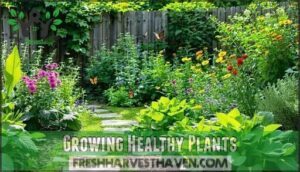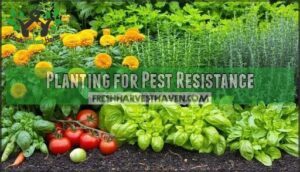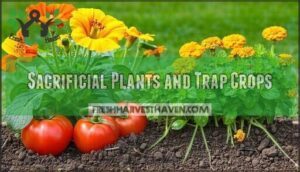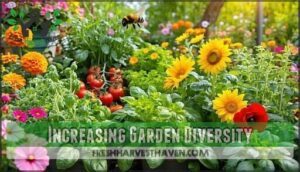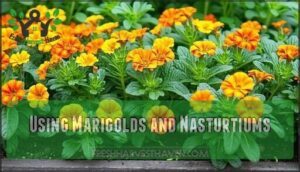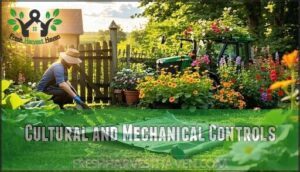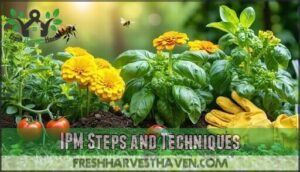This site is supported by our readers. We may earn a commission, at no cost to you, if you purchase through links.
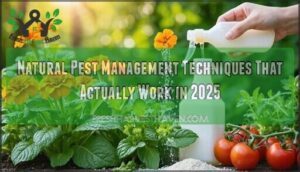 You can tackle pest problems without harsh chemicals by using natural pest management techniques that protect your family and environment.
You can tackle pest problems without harsh chemicals by using natural pest management techniques that protect your family and environment.
Start with neem oil, which disrupts insect feeding and reproduction cycles. Diatomaceous earth works like microscopic glass shards against crawling pests, while white vinegar creates acidic barriers they won’t cross.
Companion planting with marigolds and nasturtiums naturally repels unwanted insects. Physical barriers like row covers and sticky traps catch problems before they spread.
Encourage beneficial insects by planting umbelliferous flowers that attract pest predators. The secret lies in combining multiple methods for maximum effectiveness.
Table Of Contents
- Key Takeaways
- Natural Pest Control Methods
- Top 3 Natural Pest Solutions
- Growing Healthy Plants
- Companion Planting Strategies
- Integrated Pest Management
- Frequently Asked Questions (FAQs)
- What is natural pest management?
- What’s the best natural pest control?
- What is the holistic approach to pest control?
- How to make a natural pest control?
- What is meant by natural pest controlling methods?
- What is natural pest control?
- What is the best natural pest control method?
- What are organic and natural pest and disease control methods?
- What are natural pest control measures?
- Are natural pest control methods sustainable?
- Conclusion
Key Takeaways
- Attract beneficial insects by planting umbelliferous flowers like yarrow, dill, and fennel – these create natural pest control systems that can reduce pest populations by up to 60% without chemicals.
- Use targeted organic solutions like neem oil for active infestations, diatomaceous earth for crawling pests, and white vinegar barriers – these natural methods disrupt pest life cycles while remaining safe for your family.
- Build healthy soil through composting and organic matter additions to strengthen your plants’ natural defenses – healthy plants resist pests better than stressed ones, creating your first line of defense.
- Combine multiple methods through integrated pest management rather than relying on single approaches – strategic companion planting, physical barriers, and beneficial insects work together for maximum effectiveness.
Natural Pest Control Methods
You can transform your garden into a natural pest-fighting powerhouse by attracting beneficial insects that do the hard work for you.
The secret lies in planting umbelliferous flowers like yarrow, dill, and fennel, which act like five-star restaurants for ladybugs, parasitoid wasps, and other pest predators.
Attracting Beneficial Insects
Several beneficial insects transform your garden into a natural pest control system when you create the right habitat.
Lady beetles consume up to 5,000 aphids during their lifetime, while parasitic wasps control over 50% of pest insect populations.
Nature’s tiny warriors pack serious firepower—one lady beetle devours 5,000 aphids while building your garden’s defense army.
Creating pollinator gardens with insectary plants increases beneficial insect diversity by 25% compared to non-native species.
Install water sources and reduce pesticides to support these natural predators.
Habitat creation through diverse plantings, wildlife habitat areas, and insect hotels provides year-round shelter for your garden’s tiny workforce.
Using Umbelliferous Flowers
Once you’ve attracted beneficial insects to your garden, umbelliferous flowers become your secret weapon for natural pest control.
These umbrella-shaped blooms create nectar-rich environments that transform your garden into a thriving ecosystem.
Umbelliferous flowers like yarrow, dill, fennel, and cilantro offer accessible landing pads for beneficial insects.
Their flat, clustered blooms provide perfect feeding stations for lady beetles, hoverflies, and parasitoid wasps—nature’s most effective pest controllers.
Here’s how to maximize your umbelliferous flower strategy:
- Plant yarrow near aphid-prone crops – Watch hoverflies arrive within days to feast on garden pests
- Add fennel borders around vegetable beds – Create natural highways for beneficial insects seeking nectar-rich blooms
- Scatter dill throughout your garden – Attract parasitoid wasps that eliminate caterpillars and other soft-bodied pests
- Establish cilantro patches – Build ecosystem diversity while enjoying fresh herbs for your kitchen
Yarrow is also available for purchase if you want to expand your garden.
Strategic companion planting with umbelliferous flowers reduces pest populations by up to 60% while supporting garden diversity naturally.
Planting for Biodiversity
When you’re planting for biodiversity, you’re building a living insurance policy that protects your garden naturally.
Diverse ecosystems support three times more beneficial insects than single-crop gardens, creating robust food webs that keep pest populations in check.
| Plant Category | Species Examples | Benefits |
|---|---|---|
| Native Plants | Purple coneflower, black-eyed Susan | Attract pollinators, require less water |
| Companion Planting | Basil with tomatoes, carrots with onions | Natural pest deterrence, improved growth |
| Umbelliferous Flowers | Dill, fennel, yarrow | Support parasitoid wasps, ladybugs |
| Habitat Creation | Native grasses, berry bushes | Shelter for beneficial insects |
| Pollinator Plants | Lavender, bee balm, salvia | Continuous nectar sources |
Garden diversity increases natural predator populations by 35% while reducing pest outbreaks by 25%.
This approach creates sustainable habitat creation that works year-round.
Eco-Friendly Pest Control
Nature’s most effective pest fighters don’t come from a spray bottle.
You’ll discover that organic pesticides and natural solutions work better than harsh chemicals while protecting your garden’s ecosystem.
Modern eco-friendly pest control combines ancient wisdom with proven science.
Neem oil disrupts insect hormones, while diatomaceous earth creates microscopic barriers that dehydrate crawling pests.
These sustainable methods form the backbone of integrated pest management systems.
Your garden becomes a fortress when you deploy these natural solutions:
- Neem oil spray disrupts pest reproduction cycles without harming beneficial insects
- Diatomaceous earth barriers eliminate slugs, beetles, and crawling invaders through dehydration
- Garlic and pepper sprays create safe repellents that confuse pest navigation systems
- Beer traps lure slugs away from prized plants using their natural attraction to yeast
- Essential oil blends repel mosquitoes, ants, and flying pests through targeted aromatherapy
These nontoxic pest control methods protect children, pets, and pollinators while maintaining garden health.
Beneficial insects aid in natural pest control.
Eco-friendly traps capture problems without creating new ones.
Top 3 Natural Pest Solutions
When you’re dealing with stubborn garden pests, three natural solutions consistently deliver results without harming your plants or family.
These time-tested remedies work by targeting pests’ biological weaknesses, offering effective control that synthetic chemicals can’t match, with natural solutions that are safe for your family.
1. Neem Oil Insecticide Concentrate Solution
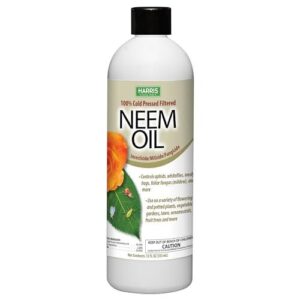
When you’re dealing with stubborn garden pests, neem oil stands as one of nature’s most reliable defenders.
This concentrated solution contains azadirachtin, which disrupts insect hormone systems and prevents reproduction in over 200 pest species.
Neem oil uses include targeting aphids, whiteflies, spider mites, and scale insects while remaining safe for beneficial pollinators like bees.
Application methods are straightforward: mix one to two tablespoons of concentrate per gallon of water with a few drops of insecticidal soap for better coverage.
The solution concentration depends on pest severity, but start with the lower rate to avoid plant stress.
Pest targeting works best when you spray during early morning or evening hours, covering both leaf surfaces thoroughly.
Safety precautions include wearing gloves and avoiding application during peak sun hours.
This organic pest control method provides up to 90% pest reduction with regular use, making it superior to many horticultural oil alternatives for integrated natural pest control programs.
2. Diatomaceous earth food grade powder
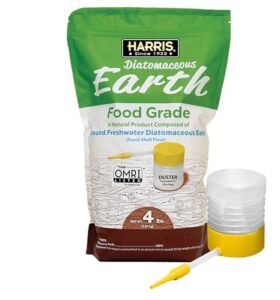
Food-grade diatomaceous earth acts like microscopic razor blades, slicing through pest exoskeletons and causing fatal dehydration within 48 hours.
Nature’s microscopic warriors slice through garden invaders with deadly precision.
This natural pest control method works by absorbing lipids from insect bodies, making it an effective insecticide alternative for crawling pests.
DE food grade transforms your home into a fortress against unwanted invaders.
You’ll eliminate fleas, roaches, bed bugs, and ants without chemical toxicity. Apply thin layers around baseboards, cracks, and infested areas during dry conditions, since moisture destroys its effectiveness.
While handling creates dust, safe application around children and pets makes cleanup worthwhile.
This organic pest control doubles as a soil amendment, enriching gardens while managing pests. DE food grade offers natural pest management that’s both practical and environmentally responsible.
Best For: Households seeking chemical-free pest dehydration solutions for crawling insects in dry indoor and outdoor spaces.
3. Natural Distilled White Vinegar Gallon
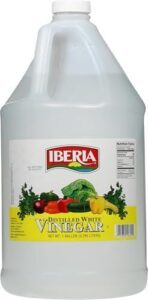
White vinegar brings reliable vinegar pest control through its acetic acid content, which disrupts soft-bodied pests like aphids and ants.
Create effective homemade pest repellent by mixing one part vinegar with three parts water for safe vinegar dilution. This natural pest control method works best as spot treatment around garden edges and household entry points.
For vinegar garden benefits, spray directly on weeds during sunny days when acetic acid concentration peaks. Store-bought gallons offer consistent strength for vinegar application tips and reliable homemade remedies.
Best For: Homeowners seeking versatile natural repellents for cleaning, cooking, and targeted pest management.
Growing Healthy Plants
You’ll discover that healthy plants naturally resist pests better than stressed or weakened ones, making soil health your first line of defense.
By focusing on proper soil preparation, organic amendments, and consistent care, you’re creating an environment where plants can thrive while pests struggle to establish themselves, which is based on the concept of complete concepts.
Improving Soil Health
Soil health forms your garden’s immune system, determining whether plants can fight off pests naturally. Test your soil pH and check for mineral imbalances that weaken plant defenses.
Add compost rich in organic matter to feed the Soil Food Web, where beneficial bacteria and mycorrhizal fungi create partnerships with plant roots. Improve soil structure through gentle aeration with a garden fork, allowing roots to breathe and nutrients to flow.
A key aspect involves balancing soil pH to optimize nutrient availability. Apply compost tea monthly to boost microbial activity, creating an underground ecosystem that naturally suppresses harmful pathogens while strengthening your plants’ resistance to pest attacks.
Organic Matter and Mulching
The foundation of successful natural pest control lies in consistent soil enrichment through organic matter and strategic mulching practices.
These natural soil amendments create the perfect environment for beneficial organisms while providing weed suppression and moisture retention naturally.
- Compost tea feeds plants while improving soil structure and water retention capabilities
- Mulch types like straw or wood chips form natural barriers against pests and regulate temperature
- Organic matter releases nutrients slowly, supporting long-term soil health and beneficial microorganisms
It is easy to find fertilizer product options for your garden.
Fertilizers and Water Management
Managing fertilizers and water strategically creates the foundation for pest-resistant plants.
You’ll need to balance nutrient delivery with moisture control to keep harmful insects at bay while supporting beneficial soil organisms.
Proper fertilizer types make all the difference in pest management.
Slow-release organic options prevent nutrient surges that attract sap-sucking pests, while synthetic nitrogen can actually increase aphid populations.
Focus on balanced formulations that strengthen plant immunity.
| Fertilizer Type | NPK Ratio | Pest Resistance |
|---|---|---|
| Compost Tea | 1-1-1 | Moderate fungal protection |
| Fish Emulsion | 5-1-1 | Strong against leaf miners |
| Kelp Meal | 1-0-2 | Excellent thrip deterrent |
Water conservation through drip irrigation reduces foliar diseases that weaken plants.
Overwatering creates perfect conditions for root rot and nematodes, while water stress makes plants vulnerable to spider mites.
Schedule early morning watering to minimize fungal spore germination.
Nutrient deficiency weakens natural defenses, so monitor soil health regularly.
Potassium-rich fertilizers boost resistance to fungal pathogens, while proper drainage prevents standing water that breeds mosquitoes and fungus gnats.
Enriching Soil With Compost
Kitchen scraps and yard waste become garden gold when properly composted, creating the foundation for robust soil health.
Your compost introduces beneficial microorganisms that naturally suppress pests and diseases while improving soil structure.
Composting food waste through traditional methods or vermicomposting creates nutrient-rich amendments that feed your plants steadily.
You’ll notice healthier plants with stronger pest resistance when you regularly add this organic matter to your garden beds, making it essential for successful organic gardening and natural pest management strategies.
Companion Planting Strategies
You can strategically pair plants to create natural pest barriers that protect your crops while reducing chemical inputs.
Smart companion planting combinations, like marigolds with vegetables or nasturtiums as trap crops, confuse pests and attract beneficial insects that keep your garden healthier.
Planting for Pest Resistance
Strategic companion planting creates natural pest barriers through careful plant selection and placement. You’ll build resistance using intercropping strategies that leverage plant defense mechanisms and soil microbes impact.
Here are 5 proven companion planting combinations for pest resistance:
- Basil with tomatoes – Natural pestresistant plants that repel hornworms while enhancing flavor
- Marigolds throughout beds – These repellent plants release compounds deterring nematodes and root pests
- Rosemary near carrots – Aromatic oils confuse carrot flies through natural pest deterrents
- Onions with brassicas – Mask scent trails that attract cabbage worms and flea beetles
- Nasturtiums as borders – Function as living mulch while repelling cucumber beetles
Resistant variety selection combined with crop rotation benefits creates balanced ecosystems where beneficial insects thrive, reducing chemical dependency substantially.
Sacrificial Plants and Trap Crops
Smart trap crop selection transforms your garden into a pest-control powerhouse.
Plant nasturtiums near vegetables to lure aphids, or position marigolds around garden borders for nematode control.
These sacrificial plants concentrate pests in designated areas, reducing damage to main crops by up to 80%.
Strategic plant placement creates effective pest diversion tactics while supporting beneficial insect boost populations naturally.
Increasing Garden Diversity
Building diverse gardens creates natural pest barriers that protect your plants while supporting beneficial insects.
Mix vegetables, herbs, and flowers to confuse harmful pests and attract natural predators.
Here’s how garden diversity strengthens your defenses:
- Attract Pollinators – Different flowering plants provide nectar throughout growing seasons
- Habitat Creation – Plant variety offers shelter for beneficial insects year-round
- Garden Resilience – Diverse ecosystems recover faster from pest outbreaks
This biodiversity approach enhances plant health naturally.
Strategic planting can also improve soil fertility naturally.
Using Marigolds and Nasturtiums
The most effective companion planting benefits come from positioning these repellent plants strategically throughout your garden beds.
Marigold pest control works through their potent flower scent repellent that deters nematodes and aphids from damaging your crops.
Meanwhile, nasturtium trap crops function as living pest magnets, drawing aphids away from your vegetables while adding vibrant garden aesthetic value.
These natural pest control techniques create an ecosystem where trap plants and pest repellent plants work together, offering dual protection while enhancing your garden’s visual appeal.
Integrated Pest Management
You’ll get the best results when you combine multiple natural pest control methods instead of relying on just one approach.
This integrated pest management strategy lets you tackle problems from different angles while building a healthier garden ecosystem that naturally resists pests.
Cultural and Mechanical Controls
Crop rotation breaks pest cycles by switching plant families seasonally, while sanitation practices remove debris that harbors overwintering insects.
Water management prevents fungal diseases, and soil solarization uses heat to eliminate soil-dwelling pests.
Handpicking pests provides immediate control for visible invaders like caterpillars.
These cultural methods complement mechanical approaches such as pest exclusion techniques, creating thorough protection without chemicals for your garden ecosystem.
Physical Barriers and Traps
Row covers and sticky traps form your garden’s protective shield against unwanted visitors. These physical barriers work immediately, giving you control without chemicals.
Row cover uses include protecting seedlings from beetles and caterpillars while allowing sunlight through. Sticky trap types capture flying pests like aphids and whiteflies effectively. Hand-picking pests offers direct removal for larger insects, while kaolin clay uses create an irritating barrier on leaves.
Gardeners can find various row covers for specific needs. Physical removal methods you can try today include setting up traps and using barriers to protect plants.
Physical removal methods you can try today:
- Set up slug beer traps using shallow dishes filled with beer to attract and drown slugs
- Install floating row covers over vulnerable plants to block flying insects completely
- Place yellow sticky traps near plants to catch aphids, whiteflies, and other flying pests
- Apply kaolin clay spray to create a protective white coating that deters insects from feeding
IPM Steps and Techniques
Through careful observation and systematic planning, your IPM program transforms from guesswork into a science-backed approach that prevents pest problems before they spiral out of control.
Successful integrated pest management requires a systematic seven-step cycle that transforms your garden into a pest-resistant ecosystem. You’ll inspect regularly, prevent problems before they start, identify threats accurately, analyze population levels, select appropriate treatments, monitor results, and document everything for future reference.
- Pest Monitoring: Check plants weekly for early signs of damage or beneficial insect activity
- Crop Rotation: Move plant families to different garden areas each season to break pest cycles
- Biological Control: Release ladybugs, parasitic wasps, or apply Bacillus thuringiensis when needed
- Soil Conservation: Test pH levels and add organic matter to strengthen plant immunity
- Habitat Management: Create diverse plantings that support natural predators year-round
Evaluating Results and Adjusting Methods
Weekly pest monitoring reveals whether your natural pest control methods deliver results.
Document which techniques work best in your conditions, noting pest population changes and plant health improvements.
When data collection shows certain methods aren’t meeting expectations, adjust your approach immediately.
Neem oil applications can disrupt pest life cycles effectively, as seen in Neem oil applications.
| Monitoring Method | Frequency | Success Indicator |
|---|---|---|
| Visual inspection | Weekly | 50% pest reduction |
| Sticky traps | Bi-weekly | Population trends |
| Beneficial insect counts | Monthly | Predator presence |
| Damage assessment | Seasonal | Yield protection |
| Method effectiveness review | Quarterly | Cost-benefit analysis |
Adaptive strategies keep your Integrated Pest Management IPM program responsive to changing conditions.
Seasonal adjustments help you stay ahead of pest cycles, while ongoing monitoring guarantees pest management strategies remain effective throughout the growing season, ensuring effective and responsive management.
Frequently Asked Questions (FAQs)
What is natural pest management?
Like a guardian angel for your garden, natural pest management harnesses nature’s own weapons to protect plants.
You’ll use beneficial insects, companion planting, physical barriers, and organic solutions to control pests without harmful chemicals.
What’s the best natural pest control?
You’ll get the best results by combining multiple approaches: attract beneficial insects with plants like yarrow and dill.
Use neem oil sprays for active infestations, and maintain healthy soil to strengthen your plants’ natural defenses, which is a key part of getting the best results.
What is the holistic approach to pest control?
A holistic approach combines multiple natural methods—attracting beneficial insects, using companion planting, applying organic sprays, creating physical barriers, and maintaining healthy soil—to create balanced ecosystems that naturally suppress pests.
How to make a natural pest control?
Mix neem oil with dish soap and water to create an effective homemade spray.
You can also combine diatomaceous earth around plant bases, garlic spray for repelling, and beneficial plants like marigolds to naturally control pests.
What is meant by natural pest controlling methods?
Studies show trap crops can reduce pest damage by up to 40%.
Natural pest control methods use biological, physical, and organic approaches instead of synthetic chemicals.
You’ll rely on beneficial insects, companion planting, barriers, and natural substances to manage pests sustainably.
What is natural pest control?
Natural pest control uses eco-friendly methods like beneficial insects, companion planting, and organic sprays to manage garden pests without synthetic chemicals, protecting your plants while maintaining environmental balance.
What is the best natural pest control method?
Like a natural fortress protecting your garden, integrated pest management combines multiple strategies for maximum effectiveness.
You’ll achieve best results by attracting beneficial insects with umbelliferous flowers, using companion planting, and applying targeted organic solutions.
What are organic and natural pest and disease control methods?
You’ll find success using beneficial insects like ladybugs, companion planting with marigolds, neem oil sprays, diatomaceous earth barriers, and trap crops like nasturtiums to naturally control pests without chemicals.
What are natural pest control measures?
You can use beneficial insects, trap crops, natural sprays, physical barriers, and companion planting to control pests organically.
These methods work together, creating a balanced ecosystem that naturally reduces pest populations without harmful chemicals, using natural methods.
Are natural pest control methods sustainable?
Ironically, you’re choosing methods that outlast chemicals by working with nature, not against it.
Natural pest control sustains ecosystems through biodiversity, beneficial insects, and soil health, creating lasting solutions without harmful residues, which is a method that outlasts chemicals.
Conclusion
Success becomes your faithful companion when you consistently apply these natural pest management techniques throughout your growing season.
By weaving together beneficial insects, physical barriers, and organic solutions, you’re creating a fortress that pests can’t penetrate.
Your garden will thrive without harsh chemicals, protecting both your family’s health and the environment.
Remember, patience and persistence with these methods will reward you with a naturally balanced, productive garden that works in harmony with nature’s own systems.
- https://extension.sdstate.edu/organic-pest-control-methods
- https://www.ncrrsepa.org/natural-pest-control-methods/
- https://www.forbes.com/home-improvement/pest-control/natural-pest-control-solution/
- https://www.homedepot.com/c/ab/natural-pest-control-for-your-outdoor-spaces/9ba683603be9fa5395fab901a0b8f57a
- https://learn.tearfund.org/en/resources/footsteps/footsteps-71-80/footsteps-77/natural-pest-management

